Andrew Mowry
Asymmetrical Two-point Mandolin
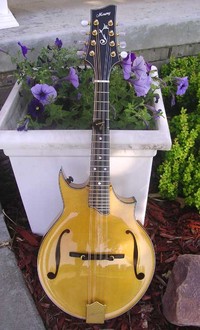 We really stumbled into Andrew Mowry by serendipity. One of our JazzMando respected regulars, Brad Weiss had just acquired a Mowry last winter and was completely lit up about it. It was primarily his contagious zeal responsible for connecting us. After we had the chance to personally pass around the beautiful two-point he'd recently completed, we were most grateful for the tip. We really stumbled into Andrew Mowry by serendipity. One of our JazzMando respected regulars, Brad Weiss had just acquired a Mowry last winter and was completely lit up about it. It was primarily his contagious zeal responsible for connecting us. After we had the chance to personally pass around the beautiful two-point he'd recently completed, we were most grateful for the tip.
Oregon seems to be a hotbed of quality builders. (Kim Breedlove, Paul Lestock, James Condino, Bob Schneider, Steve Holst, just to name a few...) Though originally hailing from Vermont, another geography wealthy with rich tonewoods and fine forests, Andrew's wife Sarah's west coast background would draw the couple back to the land of great outdoor activity and abundant fresh air. Now with the recent addition (6/27/07) of newborn son, Will, it seems a great environment to raise a family AND an excellent world-class crop of mandolins.
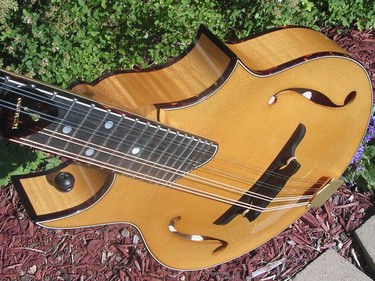
(click pictures for close-up)
Andrew has already established a growing respect for his fine F5 and A body mandolins, but what grabbed our attention was his asymmetrical two-point design. Part "Ghost of Jethro," part manufacturing economies (no $1200 strap button needed here), this body style is a logical choice for the serious jazz enthusiast. Throw in the alluring cosmetics of blond staining with tortoise trim, and you have a recipe for a stage instrument that looks as good as it sounds. That Mowry has artfully mastered the proper selection of wood and internal carving for maximum warmth and sustain, we suspect we'll be seeing much more of his craft in respected jazz circles in the future.
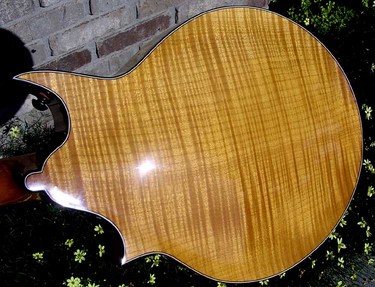
The tone of this mandolin is remarkable, but let's address initial impressions that still linger after opening the case on arrival. "Perfection" is a word to be used sparingly when describing instrument detailing. The best of the best luthiers will be able to identify their own flaws, but the astonishing reality is we had to search for minutes to come across anything less than perfect in his near machine-level binding, inlay, or finish. (No detectable filler!) This caliber detailing you'd expect only out of someone with decades of experience with wood and metal, not some young 31-year-old punk. Mowry is capable beyond his years, betraying the confidence of a crossword puzzle junkie who uses pen, and with his hankering for science (a Master's degree in physical geography), we can only imagine what kind of new sonic trails he will blaze in the many years to come, combining art and science in his tweaks and processes.

The ergonomic comfort and security played well for us (pun intended). There's a physical balance that makes holding the instrument natural even before the first strum, centering the weight of body and headstock magically midway between the arms at all times. (You just don't get this placation with an A body instrument) The strap button tucked under the top horn holds securely and tastefully out of the audience eye.
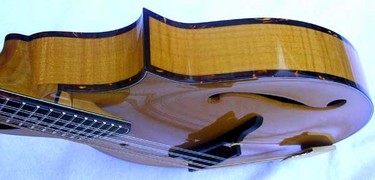
Back to tone, though. We had the opportunity to share the instrument with some of the JazzMando Lab crew, one in particular who plays in a local country/bluegrass band commenting on the instrument's healthy "chop." The irony is the mandolin's true strength is in more linear jazz playing, but her observation certainly testified to the versatility of it, though Andrew's sonic blueprint from the very beginning was for a jazz-friendly ax. Another admired its powerful projection capability. (You can't use the word "cannon" here; it doesn't blast through, it artfully bellows.) Mark this as yet another imitable feature, its dynamic variety. It sounds exquisite and sophisticated at low volume levels, but is more than ready to delivery some robust decibels at the other end of the spectrum with the right coaxing.
Around our shop, we used to put old cakes of rosin in a cloth bag and pound them with a hammer to produce fine grains of rosin dust to saturate newly rehaired violin bows. This is a great metaphor for the sound of this instrument. "Pounding" the strings with the picking hand yields a healthy but always controlled "spray" of sound; the tone expands but always stays rich and focused. From pick to fretting fingers, tone production is effectively articulate and bears the player-intuitive qualities one would expect of an instrument triple its price.
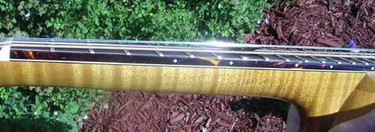
The neck profile is a good compromise in contour, appealing to a broad cross-section of players. A slight, barely noticeable "V," its medium-round back would feel great to all but the player obsessed with a radically thin or sharp V neck. We've leaned more toward the fuller "clubby" in other instruments (those particularly Rigel-like), but this is still quite desirable, likely even more marketable.
Fretting is effortless, and as we mentioned the "punch" factor makes for a very "intuitive" instrument. It just does just what the brain tells it to do, producing an astoundingly accessible, immediate degree of great tone.
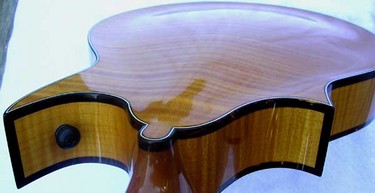
The instrument feels solid and stable. A violin-style button capping the bottom of the heel of the neck joint and reinforced carbon fibre truss rod, this neck is not going anywhere. Mowry is one of the many recent respected builder converts to embrace this 21st-century neck strengthening technology.
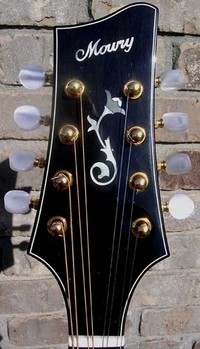 Nits? Nits?
It's hard to find anything remotely bordering on disagreeable, but we'll point out a few minor personal things we'd do differently, First, this didn't come standard with a pickguard, though it's still an option. ($100 upgrade) for those of us who prefer the guide opportunities of the p/g. Also the strap button on horn and body are hardwood, and given the choice, we'd opt for the security of leather grasping something metal, gold-plated or brass. This is something we've frequently encountered with those whose daily livelihood is working with wood; seems the organic aesthetics of grain will always be an alluring siren to most builders, opting for wood in strap buttons and often tuning buttons, too. We prefer the enduring chip-proof benefit of metal at this structurally significant stress point where so much is at stake.
It's an admittedly feeble attempt at coming up with weighty negatives, as one would struggle to come up with any reason to not like this mandolin. Base price on this is a mere $3400 (slightly more with the James tailpiece), a truly amazing value.
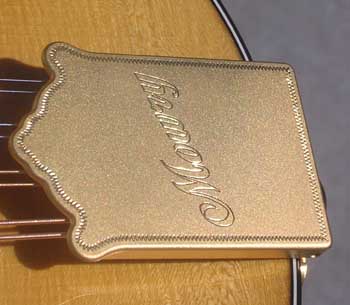
You can expect a bright future of this young woodsmith. This instrument is the sign of many good things yet to come out of this magnificent builder.
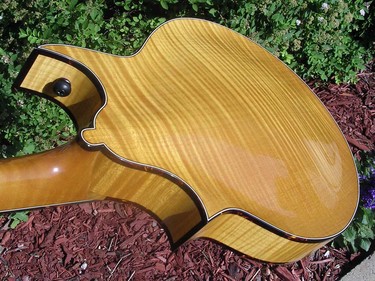
Website: Mowry Strings
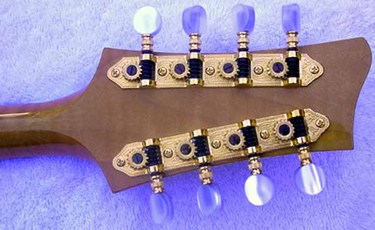
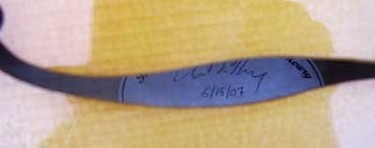
More info:
Instrument Gallery
Contact: Andrew Mowry
Process: Workshop Pics
Read up on other world class mandolin builders:


Disclaimer: In the 'Information Age' of the 21st Century,
any fool with a computer, a modem, and an idea can
become a self-professed 'expert." This site does not
come equipped with 'discernment.'
|



